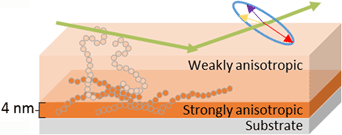No CrossRef data available.
Article contents
Characterization of chain alignment at buried interfaces using Mueller matrix spectroscopy
Published online by Cambridge University Press: 30 March 2020
Abstract

The stiffness of conjugated polymers should lead to chain alignment near buried interfaces, even if the polymer film is nominally amorphous. Although simulations predict that this alignment layer is approximately 1.5 times the persistence length, chain alignment at buried interfaces of amorphous polymers has not been experimentally measured. Using Mueller matrix spectroscopy, the optical response of regiorandom poly(3-hexylthiophene-2,5-diyl) (P3HT) was modeled in order to extract the aligned layer thickness. By approximating the optical properties of the aligned layer as that of regioregular P3HT, the data can be effectively modeled. When the film is thicker than 150 nm, optical properties are best described with a 4-nm aligned layer, which is quantitatively consistent with previous predictions.
Information
- Type
- Research Letters
- Information
- Copyright
- Copyright © Materials Research Society 2020

